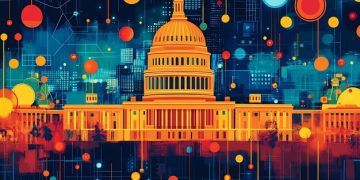Federal Education Funding: Programs with Increased Support in 2025

Federal funding for education in 2025 is seeing shifts in priorities, with certain programs receiving increased support to address evolving needs in areas like special education, career and technical training, and initiatives aimed at closing achievement gaps.
As the calendar turns to 2025, all eyes are on the evolving landscape of **federal funding for education: which programs are receiving increased support** to meet the ever-changing needs of students and educators across the nation. Understanding these shifts is crucial for stakeholders at all levels. Let’s delve into a comprehensive overview of the key changes and what they mean for the future of education.
Understanding the Federal Education Funding Landscape
The federal government plays a crucial role in supporting education across the United States. Understanding how this funding is allocated and which programs are prioritized is vital for educators, administrators, and policymakers alike. Let’s examine the broader picture of federal education funding before diving into the specific programs seeing increased support in 2025.
The Role of the Department of Education
The U.S. Department of Education is the primary federal agency responsible for overseeing education policy and administering federal funding programs. Through various initiatives, the Department of Education aims to promote educational excellence, ensure equal access to educational opportunities, and support innovation in teaching and learning.
Key Legislation Shaping Federal Funding
Federal education funding is often guided by significant pieces of legislation. The Every Student Succeeds Act (ESSA) is a prime example, reauthorizing the Elementary and Secondary Education Act (ESEA). ESSA outlines how federal funds are distributed to states and school districts, emphasizing accountability and flexibility in addressing the diverse needs of students.
- Title I, Part A: Provides financial assistance to local educational agencies (LEAs) and schools with high percentages or high numbers of children from low-income families to help ensure that all children meet challenging state academic standards.
- Individuals with Disabilities Education Act (IDEA): Ensures that all children with disabilities have available to them a free appropriate public education that emphasizes special education and related services designed to meet their unique needs.
- Career and Technical Education (CTE): Supports programs that integrate academic knowledge with technical and vocational skills, preparing students for college and careers.

In conclusion, grasping the federal education funding landscape requires understanding the key players, such as the Department of Education, and the legislative frameworks, like ESSA and IDEA, that shape funding priorities.
Programs Receiving Increased Support in 2025
Several key education programs are slated to receive increased federal funding in 2025. These increases reflect a shifting focus toward addressing critical needs in areas such as special education, career and technical training, and initiatives designed to close achievement gaps among underserved student populations.
Special Education Funding (IDEA)
One of the most significant areas of increased support is special education, specifically through the Individuals with Disabilities Education Act (IDEA). This funding is designed to help states and local districts provide appropriate educational services for students with disabilities. Proposed increases in IDEA funding aim to address the growing needs of special education programs and ensure that all students receive the support they need to succeed.
Career and Technical Education (CTE) Grants
Career and Technical Education (CTE) programs are also poised to receive additional federal funding in 2025. CTE programs are designed to prepare students for high-demand careers by integrating academic knowledge with technical and vocational skills. Increased funding for CTE reflects a growing recognition of the importance of workforce development and ensuring that students have the skills and training needed to compete in the modern economy.
Title I Grants for Low-Income Students
Title I of the Every Student Succeeds Act (ESSA) provides financial assistance to schools and districts with high percentages of low-income students. The goal is to ensure that all children, regardless of their socioeconomic background, have access to high-quality education. Increases in Title I funding signal a renewed commitment to addressing achievement gaps and providing support for underserved student populations.
In summary, the proposed increases in federal funding for programs like Special Education (IDEA), Career and Technical Education (CTE), and Title I grants highlight a commitment to addressing key needs and ensuring equitable access to quality education for all students in 2025.
Specific Initiatives and Their Funding Boosts
Beyond the broader program areas, several specific initiatives within the education sector are also set to receive increased federal funding in 2025. These initiatives reflect a targeted approach to addressing particular challenges and promoting innovation in teaching and learning.
STEM Education Initiatives
STEM (Science, Technology, Engineering, and Mathematics) education initiatives are receiving increased attention and funding as the U.S. seeks to maintain its competitive edge in these critical fields. Federal funding is supporting programs that promote STEM learning in schools, provide professional development for STEM educators, and encourage more students to pursue STEM careers.
Early Childhood Education Programs
Recognizing the importance of early childhood education in setting the stage for future academic success, the federal government is also investing more heavily in early childhood education programs. Funding increases are aimed at expanding access to high-quality preschool and early learning opportunities for children from low-income families.
Mental Health Support in Schools
The mental health of students has become an increasingly important focus in recent years. As a result, federal funding is being directed toward initiatives that support mental health services in schools. This includes funding for school counselors, social workers, and mental health professionals, as well as programs that promote mental health awareness and reduce stigma.

In conclusion, increased funding for specific initiatives such as STEM education, early childhood programs, and mental health support reflects a comprehensive approach to addressing the diverse needs of students and promoting educational excellence in 2025.
The Impact of Increased Funding on Schools
The anticipated increases in federal education funding are poised to have a significant impact on schools across the nation. These changes are expected to affect various areas, from staffing and resources to program implementation and student outcomes. Let’s explore how this increased funding is likely to manifest in practical terms for schools and educators.
Hiring More Qualified Teachers
One of the most direct impacts of increased federal funding will be the ability of schools to hire more qualified teachers. With additional resources, schools can attract and retain talented educators, particularly in high-need subject areas such as math, science, and special education. This can lead to smaller class sizes, more individualized attention for students, and improved instruction.
Expanding Access to Technology
Increased funding will also enable schools to expand access to technology for both students and teachers. This includes purchasing computers, tablets, and other devices, as well as investing in internet access and digital learning resources. Technology can enhance instruction, personalize learning, and prepare students for the digital world.
Providing Additional Resources
Beyond staffing and technology, increased funding can help schools provide additional resources and support services for students. This may include hiring additional counselors, social workers, and support staff, as well as offering tutoring, mentoring, and enrichment programs. These resources can help address the diverse needs of students and promote their academic, social, and emotional well-being.
In summary, the impact of increased federal funding on schools is multifaceted, potentially leading to more qualified teachers, expanded access to technology, and increased resources for students. These changes can create a more supportive and enriching learning environment, ultimately benefiting students and educators alike.
Challenges and Opportunities Ahead
While increased federal funding for education presents numerous opportunities, it also comes with certain challenges. Ensuring that these funds are used effectively and equitably requires careful planning, collaboration, and accountability. Let’s examine some of the key challenges and opportunities that lie ahead.
Ensuring Equitable Distribution of Funds
One of the biggest challenges is ensuring that federal funds are distributed equitably to schools and districts that need them the most. This requires a fair and transparent funding formula that takes into account factors such as poverty rates, student demographics, and special education needs. It also requires ongoing monitoring and oversight to prevent misuse or inequitable allocation of funds.
Measuring the Impact of Increased Funding
Another challenge is measuring the impact of increased funding on student outcomes. It’s essential to establish clear goals and metrics for evaluating the effectiveness of funded programs and initiatives. This requires collecting and analyzing data on student achievement, graduation rates, and other key indicators. It also requires conducting rigorous evaluations to determine which programs are working and which are not.
Fostering Innovation and Collaboration
Increased funding also presents an opportunity to foster innovation and collaboration in education. By investing in innovative programs and initiatives, schools and districts can explore new approaches to teaching and learning. Encouraging collaboration between schools, districts, and community organizations can also help leverage resources and expertise.
In conclusion, addressing the challenges related to equitable distribution and impact measurement, while seizing the opportunities for innovation and collaboration, will be essential for maximizing the benefits of increased federal education funding in 2025.
Advocacy and Policy Considerations
The allocation of federal education funding is not just a matter of numbers; it’s also a reflection of policy priorities and advocacy efforts. Understanding the policy considerations that shape funding decisions and the role that advocacy plays in influencing these decisions is critical for stakeholders in the education community.
The Role of Advocacy Groups
Advocacy groups play a crucial role in shaping education policy and influencing funding decisions. These groups represent a wide range of interests, including teachers, parents, students, and administrators. They advocate for policies and funding levels that support their members and promote their goals for education.
The Importance of Parental Involvement
Parental involvement is another key factor in shaping education policy and funding decisions. When parents are actively engaged in their children’s education and advocate for their needs, policymakers are more likely to listen. Encouraging parental involvement and providing parents with the resources they need to advocate effectively can help ensure that student voices are heard.
Staying Informed and Engaged
Finally, staying informed and engaged in the policy process is essential for all stakeholders in the education community. This means following education news, attending public meetings, and contacting elected officials to express your views. By staying informed and engaged, you can help shape the future of education and ensure that funding decisions reflect the needs and priorities of students and educators.
In summary, the landscape of federal education funding is influenced by policy considerations and advocacy efforts. Active engagement from advocacy groups, parents, and informed citizens plays a pivotal role in shaping funding decisions and ensuring that the needs of students and educators are addressed.
| Key Point | Brief Description |
|---|---|
| 🎓 IDEA Funding | Increased support for students with disabilities. |
| 🛠 CTE Programs | More funding for vocational skills training. |
| 🍎 Title I Grants | Support for schools with low-income students. |
| 🧠 Mental Health | Increased resources for mental health services in schools. |
Frequently Asked Questions
▼
Programs such as Special Education (IDEA), Career and Technical Education (CTE), and Title I grants for low-income students are expected to receive the most significant funding increases in 2025.
▼
Increased funding can enable schools to hire more teachers, expand access to technology, provide additional resources and support services for students, and implement innovative programs.
▼
Challenges include ensuring equitable distribution of funds, measuring the impact of increased funding on student outcomes, and fostering innovation and collaboration within the education sector.
▼
Advocacy groups represent diverse interests and advocate for policies and funding levels that support their members and promote their goals for education, influencing policy and funding decisions.
▼
Parents can get involved by staying informed about education issues, attending school board meetings, contacting elected officials, and joining parent-teacher organizations to voice their concerns and advocate for their children’s needs.
Conclusion
In conclusion, the landscape of **federal funding for education** in 2025 is marked by increased support for programs targeting special education, career readiness, and equity. While these funding boosts present significant opportunities for schools and students, it’s crucial to address challenges related to equitable distribution, impact measurement, and fostering innovation to ensure that these resources are utilized effectively and benefit all learners.





